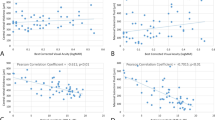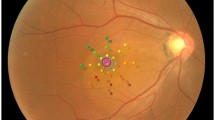Abstract
To evaluate the correlation between functional and anatomical assessments with multifocal electroretinography (mfERG) and optical coherence tomography (OCT) in patients with acute central serous chorioretinopathy (CSC). Thirty-four eyes of 34 patients with acute CSC underwent mfERG and OCT examinations. First-order mfERG N1 and P1 response amplitudes and latencies were analyzed. OCT parameters measured included central subretinal fluid (SRF) thickness, central retinal thickness, total central foveal thickness, vertical, and horizontal diameters of SRF, and macular volume. Correlation analyses were performed between best-corrected visual acuity (BCVA), mfERG parameters, and OCT measurements. Correlation analysis showed that logMAR BCVA was significantly correlated with mfERG N1 amplitudes of rings 1 and 2 (P = 0.006), N1 latency of ring 4 (P = 0.012), and P1 latency of ring 1 (P = 0.036). No significant correlation was observed between logMAR BCVA and any of the OCT measurements. For the correlation between mfERG parameters and OCT measurements, mfERG N1 and P1 latencies of the paracentral rings were significantly correlated with the central SRF thickness (P ≤ 0.024), diameters of the SRF (P ≤ 0.018), and macular volume (P ≤ 0.030). MfERG responses but not OCT measurements correlated with logMAR BCVA in patients with acute CSC. The amount of SRF nonetheless correlated with the mfERG N1 and P1 latencies of the paracentral rings, suggesting that impairment in the conduction of electrical responses in the paracentral macula is proportional to the severity of serous macular detachment in CSC. MfERG and OCT can complement each other in the functional and anatomical assessments in CSC.


Similar content being viewed by others
References
Gass JD (1967) Pathogenesis of disciform detachment of neuroepithelium: II. Idiopathic serous chorioretinopathy. Am J Ophthalmol 63:587–615
Piccolino FC, De La Longrais RR, Ravera G, Eandi CM, Ventre L, Adollahi A, Manea M (2005) The foveal photoreceptor layer and visual acuity loss in central serous chorioretinopathy. Am J Ophthalmol 139:87–99
Iida T, Hagimura N, Sato T, Kishi S (2000) Evaluation of central serous chorioretinopathy with optical coherence tomography. Am J Ophthalmol 129:16–20
Hee MR, Puliafito CA, Wong C, Reichel E, Duker JS, Schuman JS, Swanson EA, Fujimoto JG (1995) Optical coherence tomography of central serous chorioretinopathy. Am J Ophthalmol 120:65–74
Montero JA, Ruiz-Moreno JM (2005) Optical coherence tomography characterisation of idiopathic central serous chorioretinopathy. Br J Ophthalmol 89:562–564
Nakajima H, Mizota A, Tanaka M (2007) Technical note: method for estimating volume of subretinal fluid in cases of localized retinal detachment by OCT ophthalmoscopy. Ophthalmic Physiol Opt 27:512–517
Lai TY, Chan WM, Lai RY, Ngai JW, Li H, Lam DS (2007) The clinical applications of multifocal electroretinography: a systematic review. Surv Ophthalmol 52:61–96
Lai TY, Lai RY, Ngai JW, Chan WM, Li H, Lam DS (2008) First and second-order kernel multifocal electroretinography abnormalities in acute central serous chorioretinopathy. Doc Ophthalmol 116:29–40
Huang S, Wu D, Jiang F, Wu L, Liang J, Luo G, Wen F, Ma J (2002) The multifocal electroretinogram in central serous chorioretinopathy. Ophthalmic Physiol Opt 22:244–247
Vajaranant TS, Szlyk JP, Fishman GA, Gieser JP, Seiple W (2002) Localized retinal dysfunction in central serous chorioretinopathy as measured using the multifocal electroretinogram. Ophthalmology 109:1243–1250
Zhang W, Zhao K (2003) Multifocal electroretinography in central serous chorio-retinopathy and assessment of the reproducibility of the multifocal electroretinography. Doc Ophthalmol 106:209–213
Suzuki K, Hasegawa S, Usui T, Ichibe M, Takada R, Takagi M, Abe H (2000) Multifocal electroretinogram in central serous chorioretinopathy. Jpn J Ophthalmol 44:571
Chappelow AV, Marmor MF (2000) Multifocal electroretinogram abnormalities persist following resolution of central serous chorioretinopathy. Arch Ophthalmol 118:1211–1215
Marmor MF, Tan F (1999) Central serous chorioretinopathy: bilateral multifocal electroretinographic abnormalities. Arch Ophthalmol 117:184–188
Moschos M, Brouzas D, Koutsandrea C, Stefanos B, Loukianou H, Papantonis F, Moschos M (2007) Assessment of central serous chorioretinopathy by optical coherence tomography and multifocal electroretinography. Ophthalmologica 221:292–298
Sutter EE, Tran D (1992) The field topography of ERG component in man. Part 1. The photopic luminance response. Vision Res 32:433–466
Hood DC, Bach M, Brigell M, Keating D, Kondo M, Lyons JS, Palmowski-Wolfe AM (2008) ISCEV guidelines for clinical multifocal electroretinography (2007 edition). Doc Ophthalmol 116:1–11
Costa RA, Calucci D, Skaf M, Cardillo JA, Castro JC, Melo LA Jr, Martins MC, Kaiser PK (2004) Optical coherence tomography 3: automatic delineation of the outer neural retinal boundary and its influence on retinal thickness measurements. Invest Ophthalmol Vis Sci 45:2399–2406
Apostolopoulos MN, Koutsandrea CN, Moschos MN, Alonistiotis DA, Papaspyrou AE, Mallias JS, Kyriaki TE, Theodossiadis PG, Theodossiadis GP (2002) Evaluation of successful macular hole surgery by optical coherence tomography and multifocal electroretinography. Am J Ophthalmol 134:667–674
Li D, Horiguchi M, Kishi S (2004) Tomographic and multifocal electroretinographic features of idiopathic epimacular membranes. Arch Ophthalmol 122:1462–1467
Author information
Authors and Affiliations
Corresponding author
Rights and permissions
About this article
Cite this article
Yip, Y.W.Y., Ngai, J.W.S., Fok, A.C.T. et al. Correlation between functional and anatomical assessments by multifocal electroretinography and optical coherence tomography in central serous chorioretinopathy. Doc Ophthalmol 120, 193–200 (2010). https://doi.org/10.1007/s10633-010-9213-6
Received:
Accepted:
Published:
Issue Date:
DOI: https://doi.org/10.1007/s10633-010-9213-6




